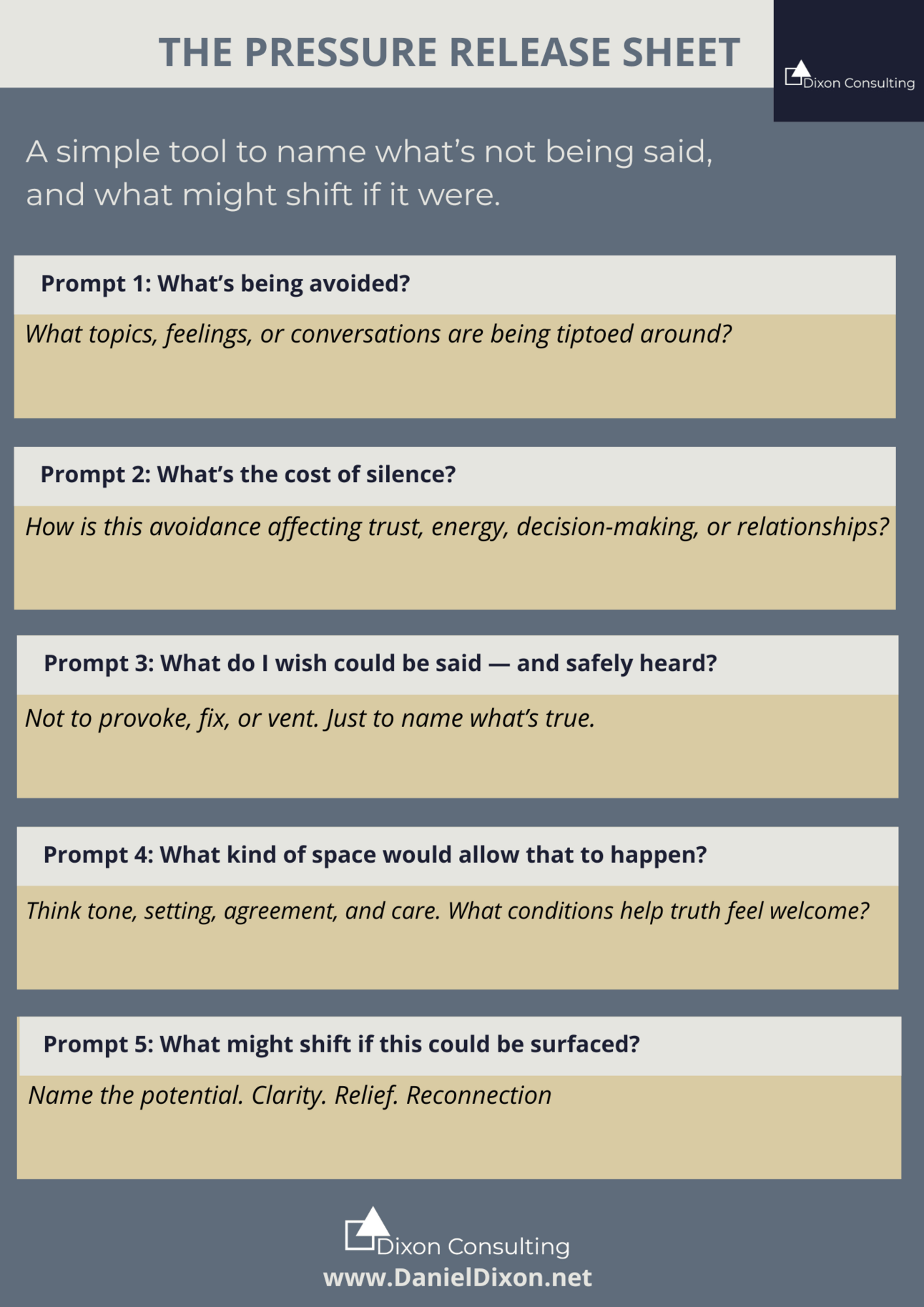- Beyond Work Monthly
- Posts
- When the Room Feels Tight
When the Room Feels Tight
On the invisible pressure to perform trust, alignment, or positivity, and what happens when we stop pretending

There’s a kind of exhaustion that doesn’t come from long hours or heavy workloads, but from the quiet effort of holding things in. When a group, family, or team is carrying tension that no one’s naming, it creates pressure. Not always visible, but definitely felt. You end up managing around it, trying not to make it worse, while wondering if anyone else notices the weight of what’s unsaid.

Over the past few years, I’ve worked with different groups navigating change. Not just at work, but in wider settings too. One situation has stayed with me. On the surface, everything looked fine. The people involved were capable and committed. Things were still getting done. But underneath, something was stuck. Conversations were looping, trust felt thinner than it should, and energy was low. Everyone seemed to know something was off, but no one quite knew how to say it out loud.
We started a series of sessions to explore what hadn’t been said. These weren’t therapy, and they weren’t a place to vent. They were simply structured, well-held conversations that gave people the space to name what the recent changes had actually cost. Not just in workload, but in clarity, confidence, and how they related to one another.
It didn’t lead to a dramatic breakthrough. But something shifted. The tone changed. A few things that had previously been avoided were brought into the open. The way people listened to each other softened. You could feel more space in the room, and that alone made a difference.
That experience became the foundation for what I now call The Reframing Room. Because what helped wasn’t a big solution. It was a container. A chance to pause, speak plainly, and reset with honesty. And that kind of space is needed in more places than we tend to realise. Not just in leadership teams, but in communities, families, and friendship groups too.

The Pressure Release Sheet
This week’s toolkit is designed to be printed, shared, or used in conversation with others.
It works in group settings, households, or even for personal reflection.


The sociologist Arlie Hochschild coined the term emotional labour to describe what happens when people are paid to manage their emotions, especially in service roles where friendliness, calm, or empathy becomes part of the product. But in personal and group life, she used a different term: emotion work. That’s the unpaid, internal effort we make to shape our feelings to meet expectations. Not because we’re fake, but because we’ve learnt what’s acceptable, appropriate, or safest to express.
When a group goes through change, a restructure, a loss, a move, or a shift in roles or rhythm, people often try to maintain stability. They keep things upbeat. They avoid disagreement. They carry on as normal. On the surface, it looks like cohesion. Underneath, it’s a kind of performance.
Over time, this creates a shared silence. People sense that something’s off, but no one wants to be the one to name it. So they adapt. The brave ones withdraw. The pragmatic ones take up more space. The sensitive ones get quieter. The group isn’t broken, but it becomes stuck. Not because of conflict, but because no one has created the conditions for honesty.
This is where Hochschild’s concept of feeling rules comes in, those often unspoken norms that tell us what’s okay to feel, how strongly, and for how long. If every meeting rewards optimism, if every dinner expects harmony, if certain topics are always off-limits, people begin to self-monitor. They perform connection instead of living it.
What helps isn’t confrontation. It’s atmosphere. It’s creating a space where truth can land softly and without judgement or escalation. The most transformative groups I’ve worked with didn’t change because of clever strategies or new values on a PowerPoint. They changed when someone said, “I think we need to talk about what’s really going on.” And someone else responded, “Thank you.”
When that happens, the tone shifts. People stop performing and start relating again. That’s when the group begins to breathe, not just function, but connect.
When you create a space where truth can land softly, people stop performing and start relating again. That’s when the group begins to breathe.

You don’t need to wait for a crisis to ask, “What aren’t we saying?” Sometimes the pressure we feel isn’t from disagreement but from disconnection. And often, it only takes one thoughtful invitation, one person willing to be a little more honest to help others do the same.
You don’t have to say everything. You don’t have to solve it all. But if the room feels tight, it’s okay to ask: “Can we talk about this?”

The Reframing Room is a set of structured, psychologically grounded offers to help people navigate tension, change, and emotional stuckness — together. It’s designed for leadership teams, partnerships, boards, communities, and groups of any kind trying to move forward when something feels misaligned. You can explore the full offer, including example sessions and the downloadable brochure, at: And if you’d like to have a quiet conversation about what’s happening in your group, I’d be happy to listen. |  |
If you’re navigating a transition or feel stuck in the in-between, my coaching sessions are designed to meet you there gently, clearly, and without pressure. You can book a 15-minute intro call here: https://calendar.app.google/rkUSYjRysGgpmV7V9 Or explore more at www.danieldixon.net |  |

The Art of Gathering
by Priya Parker
What it’s about:
This is a book about why we gather, how we gather, and what makes gatherings meaningful, beyond logistics and agendas. Parker challenges the idea that structure kills spontaneity, showing instead how intentional design and clear purpose can create spaces where people connect more deeply and honestly.
Why it resonates:
Much like the themes in this week’s newsletter, The Art of Gathering reminds us that the quality of a group conversation isn’t accidental. When we don’t set the tone or create safety, people fall into roles, habits, or performance. Parker’s work offers a blueprint for creating gatherings that invite presence, vulnerability, and transformation, whether it’s a dinner table, a workshop, or a leadership offsite.

Until next time
You don’t need perfect words to say something real. Often, the most meaningful shifts begin not with certainty but with a quiet moment of honesty, the kind that says, “This matters, even if I don’t know how to fix it.”
If something has been sitting just under the surface this week, you don’t have to turn it into a big conversation. You can start by noticing it, naming it for yourself, and creating a bit more space around it.
That alone is enough.
Until then, I’m glad you’re here.
Daniel
 | How do people stay hopeful during uncertainty? I’m gathering anonymous insights for The Hope Inventory, a short, reflective survey exploring how people navigate instability, rebuild agency, and stay motivated through change. If you’ve experienced job loss, career transition, or prolonged uncertainty, I’d value your perspective. Your responses will help shape a visual report and deeper analysis within my consulting work on human resilience and workplace culture. |
Reply